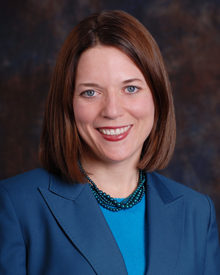In honor of Car-Free Day, George Washington Today caught up with Meghan Chapple-Brown, director of GW’s Office of Sustainability. Ms. Chapple-Brown, who had just come in from riding her bike to campus from her Silver Spring, Md., home, talked about a variety of new and expanded programs GW is working on to encourage car-free and environmentally friendly commuting.
Q: What sort of new transportation initiatives is GW working on right now?
A: As part of our Climate Action Plan (CAP), GW is committed to reducing our carbon footprint as it relates to transportation. That’s pretty unique for an institution of higher education. We’re very well positioned to address it, given our location close to so many different modes of transportation. There’s Capital Bikeshare, buses, the Metro and lots of places are accessible by walking as well. In the spirit of Car-Free Day, we’re launching some initiatives to raise awareness and encourage people to take the next step toward more carbon-free transportation.
One thing we’ve been working on is a partnership with Lerner Health and Wellness Center to offer discounted memberships for bikers or walking commuters so they can access shower facilities—so anyone who bikes or walks to work doesn’t have to try to clean up in their office bathroom. This was originally an idea in the CAP, and it’s come together based on the work of people in several places: Lerner Health and Wellness Center, GW Housing Programs, the Office of Sustainability, and the GWorld office, which is working on making it possible for people who buy these discounted memberships to swipe into the building. Everything should be ready before the end of the semester, and we’ll announce the date as we get closer to it.
Q: What other transportation options are available to GW students, faculty and staff members that don’t involve driving a personal car?
A: There’s Metro, the buses, including the Circulator, and the Vern Express shuttles between campuses. There’s also NuRide, a commuter connections service that helps people find carpools and earn rewards for taking “greener” trips. We are currently exploring the feasibility of running a shuttle from West Virginia to GW’s Virginia Science and Technology Campus to help accommodate commuters from that area. And the CAP transportation team is continuing to look into other options.
Q: Some people may have noticed that new electric car chargers have been installed in the Academic Center garage. What should we know about those?
A: There’s an effort by the federal government—the Department of Energy—to pilot electric charging stations and create a network. The idea is that it’s a chicken-and-egg technology: the more charging stations there are, the more security or reliability there is for people to lease or buy an electric vehicle. So the market needs charging stations that are networked and well distributed, and it also needs people who have electric cars to use the stations. In an effort to support the market shift and that momentum, we’re going to be piloting one of the network stations here on campus. It’s in the Academic Center garage. It’s part of a program being facilitated by ChargePoint America.
GW has one station that charges two cars at a time. This station and others like it will help determine how to price and schedule the use of these stations. This is a pilot program. GW is one of many universities and other intuitions that are part of the initiative. We’re working now to get the station networked. “Networked” means that anyone driving around the area will be able to see our station pop up on a map, and see where they can plug in their cars. It uses cell phone network technology. The station had to be in a publicly accessible place, and the Academic Center garage is open to the public. The station should be ready to use by the end of 2011.
Q: Tell us more about the university’s Climate Action Plan and how it relates to transportation.
A: Our Climate Action Plan focuses on reducing our greenhouse gas emissions by making our buildings more efficient, looking at how we source our power and getting more from renewable sources, and minimizing our transportation footprint.
I’d like to give a shout out to the transportation implementation team that has really worked on increasing bike amenities on campus, including plans to add more bike racks. That includes the Health and Wellness Center, the Department of Parking and Transportation, Campus Planning, Student and Academic Support Services and the University Police Department.
Right now, we have 77 bike racks on campus that provide 492 bike spaces. And when the Law Learning Center Garage is completed, there will be 103 new bike parking spots by summer 2013. When you benchmark our transportation efforts against other schools’, we’re doing pretty well. The Sierra Club’s Coolest Schools Rankings for 2011 rate GW an 8.5 out of 10 in terms of terms of green transportation.
Q: How else is the Office of Sustainability encouraging bike riding?
A: Our office is sponsoring a raffle for 50 discounted memberships to Capital Bikeshare. People can take the Car-Free Day pledge today and sign up for the raffle. Capital Bikeshare is really popular on campus. The university’s Capital Bikeshare station on 21st and Eye streets is ranked ninth in terms of usage out of 116 stations in the D.C. metro area.


